Join us for conversations that inspire, recognize, and encourage innovation and best practices in the education profession.
Available on Apple Podcasts, Spotify, Google Podcasts, and more.
 “The best part about teaching life science is that I think the kids really relate to it. It gives them a hands-on experience. They can actually sit and observe something and relate to it. Some of the other sciences are a little bit more abstract and they’re not able to have that hands-on experience, so it’s life science that they really enjoy.”
“The best part about teaching life science is that I think the kids really relate to it. It gives them a hands-on experience. They can actually sit and observe something and relate to it. Some of the other sciences are a little bit more abstract and they’re not able to have that hands-on experience, so it’s life science that they really enjoy.”
Like Mary Bitterlich, Sally Florkiewicz teaches third grade in Glennon Heights in Lakewood, CO.
Sally says that the best part about teaching life science is that her students love it. “They’re natural little scientists,” she explains. “They’re always asking questions, always wondering, and always wanting to observe how things work.”
 Lesson at a Glance:
Lesson at a Glance:
Curriculum: Science T.R.A.C.S. (Teaching Relevant Activities for Concepts and Skills), Biological Sciences Curriculum Study, Kendall/Hunt Publishing Company
Grade: Third
Topic: Life Cycles
Glennon Heights Elementary School uses the Biological Sciences Curriculum Study’s (BSCS) Science T.R.A.C.S. (Teaching Relevant Activities for Concepts and Skills) curriculum, which spans from kindergarten through fifth grade. Sally explained that in first and second grade, students learn about what plants and animals need for survival. In third grade, the focus becomes the life cycles of plants and animals.
For the video for Session 4, Sally’s students explored plant life cycles, the complement to the studies of the animal life cycles in Mary Bitterlich’s classroom (Session 3). Like Mary, Sally began by handing out pictures of various plants and animals, and asking the question: “What was it before?”
“ From looking at their posters and listening to them work, I felt that the kids understood that plants start out as seeds,” said Sally. She then handed out “mystery objects” – a brine shrimp egg and a seed that looked similar – and asked the students to figure out what they were. As a group, the class decided to place both objects in both saltwater and soil, and then wait to see which would thrive in each environment. Sally explained that she finds that the activity is a good way, first, to get her students thinking about the different environmental needs of plants and animals and, second, to allow them to contrast the life cycles of plants and animals.
After that, the class moved on to a study using Fast Plants, which are plants that have been developed to have a short life cycle. This allows students to make meaningful observations without having to wait through a typical plant life cycle.
In the activity featured in the video, Sally’s students examined the Fast Plants, which had begun flowering, to try to figure out what would happen next in their life cycle. In particular, she wanted them to think about where seeds come from. The students first observed the plants and then drew posters depicting their predictions.
After the lesson, Sally explained that her students needed more time to work on their ideas: “They had a clear understanding that the flower was somehow related to the seed, but many thought the seed would simply fall out of the flower,” she explained.
The goal of the study was for the students to understand the plant life cycle, and just a few days later, the Fast Plant’s seeds matured, allowing Sally’s students to observe where seeds originate.
 Lesson Goals:
Lesson Goals:
Students observe and identify the life stages of a typical plant.
Students understand that plants progress through sequential stages that include a beginning, immature stages, and an adult stage
Consider the goals for this lesson as listed above. How can you create a lesson appropriate for your classroom that will fulfill similar goals?